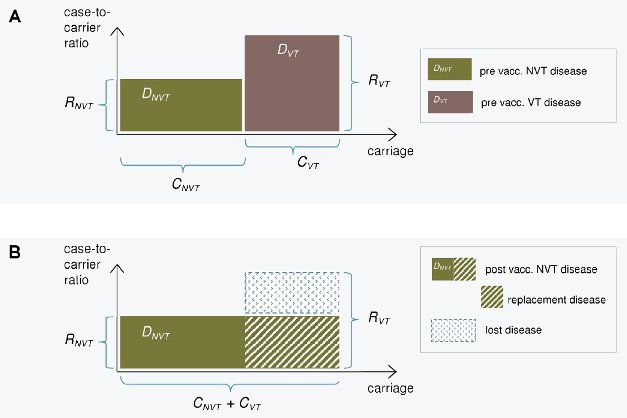Epidemiological modelling: Difference between revisions
mNo edit summary |
mNo edit summary |
||
| Line 20: | Line 20: | ||
==Answer== | ==Answer== | ||
Predicted number of invasive pneumococcal disease (IPD) cases in different age groups | Predicted number of invasive pneumococcal disease (IPD) cases in different age groups (ss obtained from the model). | ||
==Rationale== | ==Rationale== | ||
Revision as of 14:17, 18 June 2014
| Moderator:Nobody (see all) Click here to sign up. |
|
|
| Upload data
|
Question
How to predict the net effectiveness of a pneumococcal conjugate vaccination with a given set of serotypes when the vaccine is included in the national immunisation programme?
Scope
- Focus is on the number of invasive pneumococcal disease (IPD) cases in different age groups.
- Vaccine efficacy, vaccination coverage and time since the onset of the vaccination programme are high/long enough to justify the assumption of elimination of vaccine type carriage and disease.
- Vaccine type carriage is fully replaced by carriage of the non-vaccine types and the disease causing potential of different serotypes is not altered by vaccination.
Answer
Predicted number of invasive pneumococcal disease (IPD) cases in different age groups (ss obtained from the model).
Rationale
- The epidemiological model for pneumococcal carriage and disease is based on the assumption that vaccination completely eliminates the vaccine type carriage in a vaccinated population and this carriage is replaced by non-vaccine type carriage. The implications of this replacement on the decrease or increse in pneumococcal disease then depend on the disease causing potential of the replacing types compared to that of the replaced types. To predict post vaccination disease only pre vaccination data on serotype specific carriage and disease is used.
- The model is assumed to be valid in a population in which an infant pneumococcal conjugate vaccination has been in use for several years s.t. a new steady-state after vaccination has been reached. Coverage of vaccination and vaccine efficacy against carriage are assumed to be high enough to justify the assumtion of full elimination of vaccine type carriage among both the vaccinated and also, due to substancial herd effects, among the unvaccinated members of the population.
- The consequences of serotype replacement in the model depend on two key assumptions regarding the new steady-state after vaccination:
- the relative serotype proportions among the non-vaccine types are not affected by vaccination (proportionality assumption);
- the case-to-carrier ratios (the disease causing potentials) of individual serotypes remain at their pre-vaccination levels.
- The implications of vaccination on disease incidence are assumed to be solely due to the elimination of vaccine type carriage and its replacement by non vaccine type carriage. An exception to this is when a possibility of efficacy against disease without any efficacy against carriage is assumed for certain serotypes.
Figure 1. Illustration of the replacement model. The incidence of pneumococcal carriage (x-axis) and case-to-carrier ratios (y-axis) for vaccine serotypes (VT) and non-vaccine serotypes (NVT) before (panel A) and after vaccination (panel B). The incidences of disease (DNVT and DVT) are obtained by multiplication of the two quantities and correspond to the areas of the rectangles. After vaccination, VT carriage is eliminated and replaced by NVT carriage (panel B). The decrease in IPD incidence after vaccination is obtained as the difference between the eliminated VT disease and the replacing NVT disease. This is the area of the blue rectangle in panel B.
